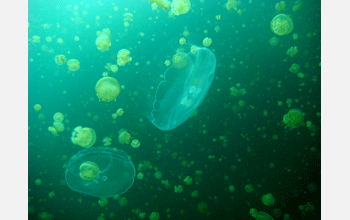Multimedia Gallery
Jellyfish Gathering
Jellyfish Gathering
Millions of Moon jellyfish (Aurelia) and golden jellyfish (Mastigias) gather in a marine lake in Palau in the Pacific. Scientists believe that Palau's gatherings, or swarms, are not caused by human activities.
More about this Image
Scientists are trying to learn more about the global movement of jellyfish--why non-native species may suddenly take root in a particular area, and also why are there sudden population explosions in parts of the world.
Moon jellyfish, which are currently found in many locations worldwide, from Asia to the Atlantic coast of the United States, were the subject of a recent study on the importance of the shipping industry to global jellyfish movements, and what role shipping may play in population changes.
Conducted by Michael Dawson of the University of California at Merced and others, the study incorporated computer simulations of the global distributions of populations of moon jellyfish over the last 7,000 years, based on ocean currents, the modest swimming abilities of jellyfish and other factors.
Juvenile jellyfish live as tiny, immobile polyps that attach themselves to hard surfaces, including the hulls of ships. In this manner, they can be transported for long distances, then detach into alien environments.
In addition, tankers and other ships transport about 10 billion gallons of ballast water, which they require in order to maintain their stability, around the globe annually. Much of this water is teeming with non-native species, including jellyfish. When jellyfish are disgorged into alien environments that are hospitable to them, they may reproduce quickly and the resulting new communities may thrive, particularly if they have no natural predators.
Results of the study show that "it is very unlikely that the current global distribution of moon jellyfish is natural," says Dawson. "Shipping is the most viable mechanism responsible for the current global distribution of jellyfish."
To learn more about the basics of jellyfish biology, what scientists have learned thus far about the worldwide increase in jellyfish populations, and the causes of jellyfish swarms and how they affect both human and marine life, see the NSF Special Report, "Jellyfish Gone Wild!" (Date of Image: January 2008)
Credit: Michael Dawson, University of California, Merced
Images and other media in the National Science Foundation Multimedia Gallery are available for use in print and electronic material by NSF employees, members of the media, university staff, teachers and the general public. All media in the gallery are intended for personal, educational and nonprofit/non-commercial use only.
Images credited to the National Science Foundation, a federal agency, are in the public domain. The images were created by employees of the United States Government as part of their official duties or prepared by contractors as "works for hire" for NSF. You may freely use NSF-credited images and, at your discretion, credit NSF with a "Courtesy: National Science Foundation" notation.
Additional information about general usage can be found in Conditions.
Also Available:
Download the high-resolution JPG version of the image. (4.7 MB)
Use your mouse to right-click (Mac users may need to Ctrl-click) the link above and choose the option that will save the file or target to your computer.

